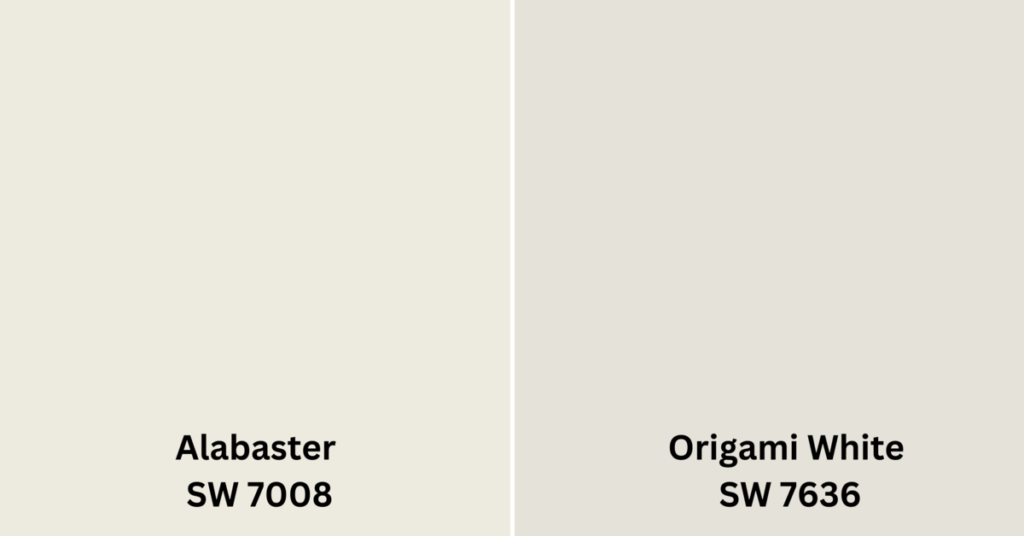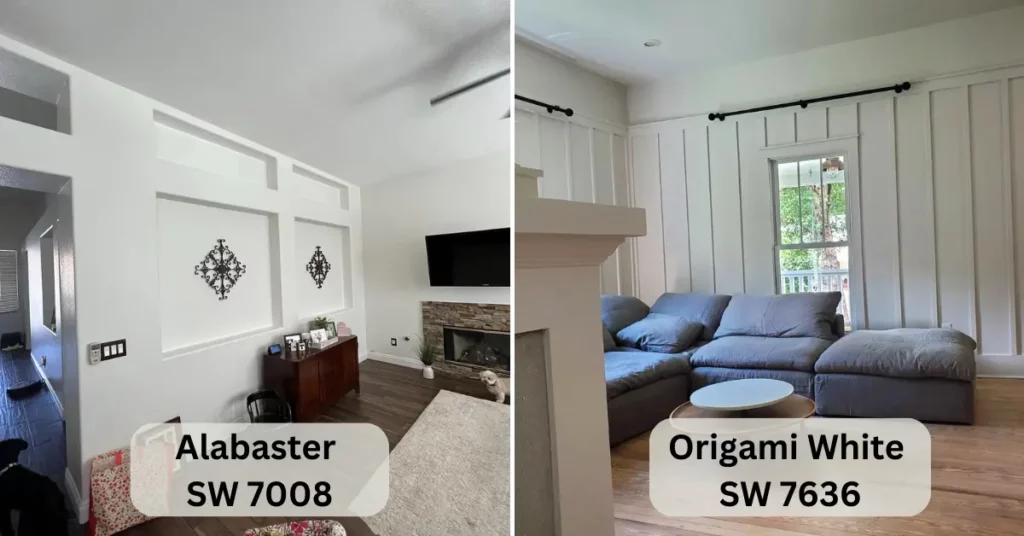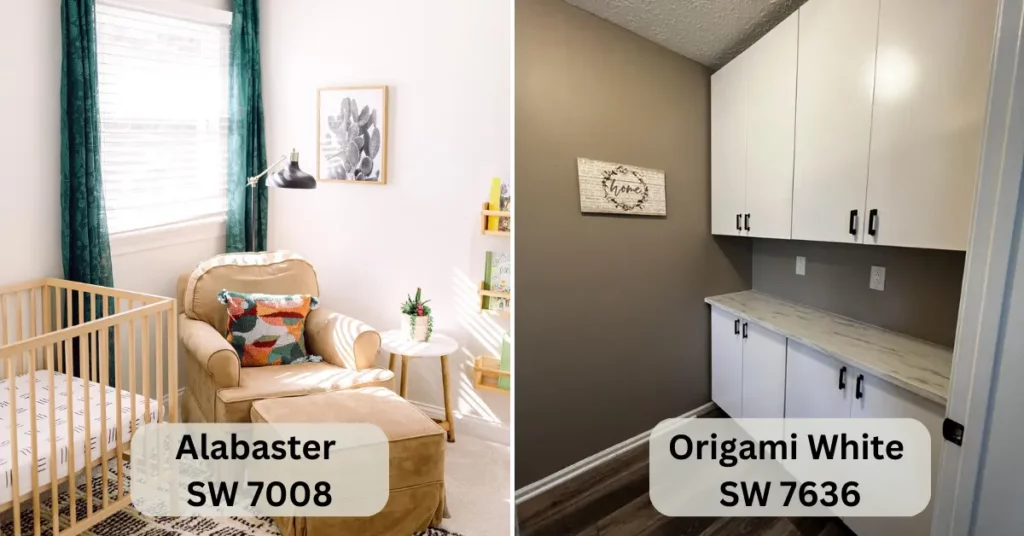The power of paint cannot be underestimated when it comes to transforming your living spaces. It’s not just about choosing a color. It’s about selecting a hue that will define the character and atmosphere of your room.
Sherwin Williams, a renowned name in the world of paints, offers various options to suit every taste and style. Among their popular choices, Alabaster and Origami White emerge as contenders, each possessing its own distinct personality.
In this exploration, we unravel the intricate dance of shades as we delve into the 11 key differences between Sherwin Williams’s Alabaster and Origami White paints.
From undertones to versatility, light interaction to room perception, this comparison aims to guide you in making a choice that resonates with your vision for your living spaces.

The Differences Between Alabaster vs Origami White
While both hues fall within the white spectrum, they possess distinct characteristics that can significantly influence the ambiance of your space. They differ in the following ways:
Undertones and Warmth
Sherwin Williams’s Alabaster and Origami White paints differ substantially regarding their undertones and warmth. Alabaster has a soft, creamy warmth that exudes coziness, while Origami White leans cooler, showcasing delicate gray undertones that create a crisp and fresh feel.
Depending on the desired ambiance, Alabaster is ideal for creating a comfortable and inviting atmosphere, while Origami White is perfect for a modern and contemporary look.
Light Reflection
Both Alabaster and Origami White offer impressive light-reflecting qualities, but the character of the light they cast sets them apart.
Alabaster creates a luminous atmosphere by illuminating spaces, while Origami White’s cooler undertones give off a different vibe. The latter imbues a slightly different character to the light it reflects, creating a refreshing and calming ambiance.

Versatility
Alabaster and Origami White are versatile colors that work well in a range of decor styles. Alabaster’s neutral warmth complements traditional and modern settings alike, seamlessly adapting to the surrounding decor.
Similarly, Origami White’s cooler base suits contemporary aesthetics particularly well but can blend effortlessly with other styles. Both colors are an excellent choice for creating a cohesive and harmonious atmosphere.
Depth and Complexity
The complexity of Alabaster’s warm undertones adds depth to walls, lending an understated elegance. On the other hand, Origami White’s cooler tones infuse surfaces with a sense of depth but with a more modern edge. The differing characters of these paints offer distinct advantages in terms of visual interest and ambiance.
You can see Benjamin Moore’s White Dove vs Alabaster to see if they can attract you.
Pairing with Accents
Alabaster harmonizes beautifully with both muted and bold accent colors, creating a balanced visual experience. The paint’s versatility means that it can be paired with various decor styles and colors, allowing for a cohesive and inviting space.
Conversely, Origami White’s cooler base can create a striking contrast with vibrant accents, producing a visually arresting effect and accentuating the modern atmosphere.

In the case of going after Alabaster, you can see Benjamin Moore’s Alabaster vs Sherwin William’s Alabaster to see whether they can lure you.
Natural Light Interaction
In natural light, Alabaster reveals its warm subtleties, making a room feel inviting and comfortable. The paint works exceptionally well in spaces that get a lot of natural light, as it enhances the warmth and coziness of the room.
With Origami White, the gray undertones interact differently with natural light, infusing a cooler ambiance that can be refreshing, making it an excellent choice for spaces that need a sense of coolness.
Trim and Molding
Both Alabaster and Origami White are great options for trim and molding, depending on the intended look. Alabaster’s warm neutrality complements the main wall color, creating a cohesive look that effortlessly suits both traditional and modern styles.
Meanwhile, Origami White provides a contrasting element due to its cooler undertones that can create a striking visual appeal. This unique touch enhances the overall visual interest in the room.
Perceived Size of the Room
Alabaster is known to have light-reflective properties that can make a room feel more open and spacious. The paint has an illuminating quality that enhances the space’s perceived size, making it an excellent choice for smaller spaces.
Conversely, the cool tones of Origami White can contribute to a crisp, expansive feeling within a space. It creates a sense of volume that can make even the smallest of spaces feel larger and more airy.
Textured Surfaces
On textured surfaces, Alabaster adds dimension by playing with light and shadow, enhancing the tactile quality. The paint’s warm and creamy undertones create an inviting and cozy ambiance that accentuates the surface’s natural textures.
Similarly, the cooler tones of Origami White on textured walls lend a contemporary edge that emphasizes the surface’s details. It creates a subtle yet visually appealing contrast in texture, enhancing the overall design.
Cohesive Color Palette
Alabaster and Origami White work exceptionally well within their respective color palettes. Alabaster’s warm, neutral tones complement warm color schemes, creating a harmonious flow throughout the space.
Origami White aligns gracefully with cooler color schemes, maintaining a coherent aesthetic that enhances the room’s overall feel. Both colors can add depth and character to any given color palette.

Exterior Application
The warm undertones of Alabaster make it an excellent choice for exterior facades, radiating a welcoming aura. Its cozy and inviting character enhances the overall feel of the exterior, resulting in a more homey and inviting look.
Meanwhile, Origami White’s cooler character can lend a modern touch to the exterior, enhancing architectural details with an impactful and contemporary vibe.
Comparison Table of Alabaster vs Origami White:
| Differences | Alabaster | Origami White |
|---|---|---|
| Undertones and Warmth | Soft, warm undertones | Cool, gray undertones |
| Light Reflection | Luminous and inviting | Crisp and fresh |
| Versatility | Adaptable to various styles | Suited for modern aesthetics |
| Depth and Complexity | Warm complexity and elegance | Modern depth with cooler undertones |
| Accent Pairing | Harmonizes with muted and bold accents | Creates contrast with vibrant accents |
| Natural Light | Emits inviting warmth | Infuses a refreshing coolness |
| Trim and Molding | Complementary warm neutrality | Contrasting cool undertones |
| Room Perception | Opens up space visually | Imparts a crisp, expansive feel |
| Textured Surfaces | Enhances dimension with light and shadow | Appeals to the traditional warmth |
| Color Palette | Fits well with warm color schemes | Aligns with cooler color palettes |
| Exterior Application | Radiates welcoming warmth | Adds a touch of modernity |
| Personal Preference | Appeals to traditional warmth | Suits a modern, slightly cooler feel |
Alabaster or Origami White: Which Shade Will Speak to Your Soul?
The palette of Alabaster and Origami White, presented by Sherwin Williams, showcases the subtle yet profound ways color can shape our surroundings.
Choosing between these two exquisite shades ultimately boils down to the story you wish to tell through your spaces. Alabaster, with its warm embrace, and Origami White, with its cooler demeanor, both offer a journey into the interplay of light, texture, and sentiment.
So, whether you envision a classic haven or a contemporary sanctuary, these two choices await, ready to bring your vision to life stroke by stroke. Remember, the canvas is yours in the realm of color, and Sherwin Williams provides the palette.

S. Pushon is a paint expert, self-taught artist, and currently working as an adviser in the paint industry as a Quality Improvement and Development Assistant.
An artist by heart, he draws remarkable art pieces and as a professional paint industry individual, he seeks the insight and shares with enthusiasts. Read more…
